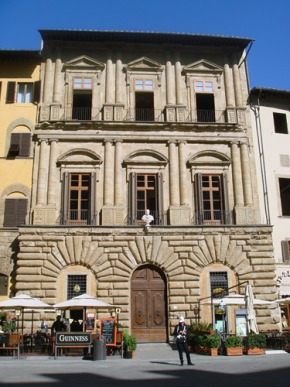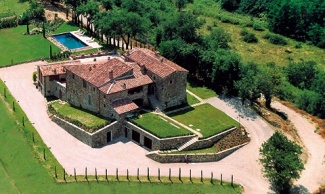Tuscany has two very different sides to it - there are the cities of art like Florence, Pisa, Siena and Lucca on the one hand, and, on the other, the breathtaking countryside, whose inviting villages, castles, villas and vineyards are a refreshing change from the frenzy of the larger Tuscan cities. Pastoral chic and high culture coexist happily in Tuscany.
Tuscan Vacations
Some come to Tuscany for the art, others to explore the extraordinary countryside. Foodies can choose wine and gastronomic itineraries, while serious gourmands can immerse themselves in weeklong farm to table organic cooking courses. Cultural tours are, of course, extremely popular. The Tuscan Riviera offers splendid beaches. For a more active holiday, go trekking in one of Tuscany's nature reserves or join a cycling tour or play golf. Besides stocking up on fine wines and single-origin olive oils, do explore the open-air antiques markets held all over Tuscany.
 Art & Culture
Art & Culture
Peopled in earliest times by the Etruscans, followed by the Romans and then witnessing the flowering of the Renaissance, Tuscany is possibly one of the greatest repositories of art in the world. Art has been expressed here in paintings and sculpture, frescoes and architectural masterpieces. Tuscany's cities are filled with museums and galleries, churches rich with sculpture and frescos, and splendid monuments built by the Renaissance masters. Any cultural tour should start at Florence, followed by Pisa and Siena. Tuscany's cities of art also include Arezzo, Cortona, Lucca and San Gimignano.
Florence
Florence is the cultural heart of Tuscany and the birthplace of the Renaissance. It was during the Renaissance that Florence acquired its magnificent palaces and squares. The statue of David by Michelangelo, the bronze Gate of Paradise of the Baptistery at the Duomo, the tombs of Machiavelli and Michelangelo at Santa Croce, paintings by the Renaissance masters, you can see them all here. Florence is an active center of the arts, with exhibitions and art festivals held regularly. In summer, art takes to the streets, with outdoor movie screenings and live entertainment in the squares. When you tire of art, head to the boutiques at the San Lorenzo market.
Pisa
Pisa's Leaning Tower has to be one of the best-known tourist sights in the world. Pisa retains much of its medieval look, filled as it is with exquisite monuments and buildings dating back hundreds of years. The historic city center is on the north bank of the Arno and still has its 12th-century walls. Combining Moorish, Gothic and Romanesque features, Pisa's most important heritage structures are the Duomo (cathedral), the cathedral's bell tower-better known as the Leaning Tower of Pisa, the circular Battistero (Baptistery), and the Camposanto or Holy Field cemetery. They are all concentrated in an area known as the Piazza dei Miracoli (Field of Miracles). The social centre of Pisa is the Piazza Garibaldi as well as the lively Borgo Stretto, full of charming shops and cafés.
Top Museums in Tuscany
Tuscany's museums and galleries span an extraordinary range of time periods and genres, so there is something for everyone. These are some of the museums you should not miss:
In Florence:
Uffizi Gallery
One of the world's top art museums, the Uffizi Gallery houses a number of key Renaissance works, including Leonardo da Vinci's Annunciation, Giotto's Maestà, Botticelli's Birth of Venus and Allegory of Spring and Michelangelo's only panel painting, the Holy Family. There are lots of sculptures and works by Titian and Rubens too.
Galleria dell'Accademia
The Accademia houses Michelangelo's David, probably the most famous sculpture in the world. Also on display is Michelangelo's unfinished masterpiece Prisoners, as well as works by Perugino, Giambologna and Botticelli.
Also visit the Bargello Museum (sculptures) and the Pitti Palace (Raphael, Rubens, Caravaggio, etc).
In Pisa:
Museo Opera del Duomo
Near the Leaning Tower of Pisa, the museum features many artworks from the tower, cathedral and baptistery. They ivory carving of the Madonna e Crocifisso is by Giovanni Pisano.
In Volterra:
Museo Etrusco Guarnacci
Over 600 Etruscan cinerary urns dominate the collection here. Also to be seen are Roman mosaics and rare Etruscan, Roman and Greek coins.
Countryside
Patches of cypress and oak, undulating vineyards and olive groves, green hills, solitary farmhouses and sunflower fields forever, Tuscany is earth's very own rustic paradise. The lovely mountain scenery offers myriad activities, including walking, climbing, bird watching, wine tasting and organic eating.
Must-Sees:
- * The medieval village of Pescia, famed for its flowers and for Carlo Collodi, the creator of Pinocchio.
- * The small traditional village of Brucciano, perched high in the hills of Northern Tuscany.
- * The medieval towns of Castelnuovo and Lucca, for stunning architecture and traditional market shopping.
- * Viareggio and Massa, for the sea.
Recommended Circuit: Begin at the tiny and secluded medieval borgo of San Quirico D'Orcia. In contrast, the nearby village of Pienza has reaped the fruits of the high Renaissance, and is a fine experiment in 15th-century town planning. Pienza is in the Val d'Orcia, some of the most beautiful countryside n Europe. Not far away is Montalcino, famed for its Brunello wine. Just below this walled town lies Antonio da Sangallo the Elder's masterpiece, the San Biagio, one of the most significant structures of the Renaissance.
Where To Stay
Destination Club Homes
Tuscan residences and clubs offer the entire range-from luxurious villas in pastoral settings to elegant apartments in historic city quarters. Selected residences are highlighted below and there's a fuller list of Italian residences here.
Solstice Villa Dolce, Florence. Located on the Piazza Della Signoria in Florence, just steps from the Palazzo Vecchio and the Uffizi Gallery. It occupies the Noble Floor (2nd floor) of a landmark building whose façade (pictured above) was designed by Michelangelo himself. This recently renovated three-bedroom property even has that rare elevator.

Quintess Terra Toscana. Located on 23 acres of Italian hillside with terraced gardens and views of the town of Radda, this traditional Tuscan villa (pictured right) is accented with Italian loggias, baked-clay masonry, and terracotta-marble and wood floors.
Exclusive Resorts Florence. Three elegant residences are in the Lungarno Suites, a chic pied-a-terre in the heart of Florence, right beside the world-famous Ponte Vecchio with charming views of the Arno River.
Equity Estates Florence. This two bedroom penthouse has views over the Arno River and the famous Ponte Vecchio.
The Hideaways Club Podere Le Sensaie, This stunning 150-year-old restored farmhouse is just 3km from the 12th-century village of Lajatico. Set in two and a half acres of landscaped gardens, the elevated farmhouse enjoys panoramic views of the region.
Private Residence Clubs
Borgo di Vagli, Arezzo. Borgo di Vagli is the first fully restored 14th century hamlet available for fractional vacation-home ownership. As an owner, you have the unique opportunity to own an affordable, authentic home in the heart of Tuscany. Luxus Vacation Properties has a 2 bedroom residence at Borgo di Vagli.
Castello di Casole, Siena. Dotting the 5,500-acre estate are restored Casali farmhouses each with dramatic glass-tiled private pools. Expect personal chefs and a full-service spa.
Castiglion Del Bosco, Montalcino. This historic wine estate offers 21 meticulously restored and individually decorated 16th and 17th century farmhouses (two- to six-bedroom configurations).
Palazzo Tornabuoni, Florence Billed by Travel + Leisure magazine as one of the world's 10 most exciting developments, 36 elegant residences (in studio, one, two and three-bedroom configurations) are located within this restored 15th-century palace in the heart of Florence.
Other Luxury Accomodation
Adler Thermae Spa. This new spa hotel is situated in the heart of Val d'Orcia a world heritage site. The spa incorporates the local thermal waters that have been popular with the Romans, Medici Princes and Popes.
Villa La Massa. Located 10 minutes outside Florence, the restored 16th-century villa has been rated by Conde Nast Traveler as one of the top 25 small hotels in the world. From Winston Churchill to David Bowie, they've all been here. Portofino Club members can use an elegant one-bedroom junior suite overlooking the Arno.
Villa La Vedetta. This boutique 18 room hotel provides wonderful views of the city of Florence. Guests can enjoy the contemporary Michelin star-winning cuisine.
The Tuscan Year
The Tuscan calendar is a busy one, although the majority of events are held in summer. Many of the sagre (food festivals) kick off in early summer and carry on through the fall as local specialties like wine, olive oil, truffles, etc, come into season.
Palio di Siena: A bareback horse race held around Siena's dirt-packed Piazza del Campo. Biannual, on July 2 and August 16. The contrade (traditional neighborhoods) compete for the palio, or banner, of the Virgin Mary. There is costumed pageantry before the races, and much feasting.
Calcio Storico, Florence: An event to commemorate John the Baptist, the city's patron saint, it centers around the game of Calcio Storico, which combines soccer, rugby and wrestling, all in medieval costume. June 24.
Giostra del Saracino, Arezzo: The night version of the Saracen Tournament is held in Arezzo's Piazza Grande on the third Saturday in June (the day version is in autumn).
Pistoia in July: The Pistoia Blues Festival, held in the first half of July, attracts blues musicians from around the world. Giostra dell'Orso, a medieval jousting tournament, is held every July 25.
Carnival in Viareggio: About a month before Easter, many Tuscan towns stage carnivals-perhaps the last opportunity to celebrate before Lent. The celebrations at Viareggio are the best known, with masked pageants, fireworks, and parades along the Tuscan Riviera.
Maggio Musicale Fiorentino, Florence: The Maggio Musicale or May Music Festival, held from late April through June, is a series of internationally acclaimed classical music concerts and recitals, opera and ballet in venues across Florence.
Insider's Tuscany
In spite of being one of the most popular holiday destinations in the world, there is much in Tuscany that is still little-known or secret. Try Arezzo, home of Guido d'Arezzo, inventor of the modern musical scale. Arezzo's architectural jewels include the Duomo, with frescoes by Piero della Francesca and a tomb by Giotto, and the 15th-century church of Santa Maria delle Grazie. Nearby Cortona is one of the oldest towns in Tuscany. Its Etruscan wall is still intact, and serves to distinguish it from the surrounding vineyards.
The Maremma, a flat area by the sea, is the Italian 'Wild West' where you will find butteri (cowboys) minding their herds. The nature reserve here along the coast makes for lovely walks.
Ten miles off the coast is Elba, the island where Napoleon was exiled. You can still visit his two homes here.
Fast Facts
Region of Italy. On the west coast along the Tyrrhenian Sea.
Capital: Florence
Geography: Mainly mountainous and hilly, with a flat area beside the sea (the Maremma). The coastline includes both long stretches of sand as well as headlands. The Tuscan archipelago consists of numerous small and enchanting islands.
Getting there: International flights come in to Milan or Rome, from where one can rent a car for the three-hour drive to Tuscany. Important regional airports are at Florence and Pisa.
By train: Florence, Pisa and Grosseto are all major train stations.
Best-known Tuscan Wines: Chianti, Vino Nobile di Montepulciano, Morellino di Scansano and Brunello di Montalcino.
Useful Websites
Tuscany tourism:
www.turismo.toscana.it/
City websites:
Florence: english.firenze.net/
Pisa: www.comune.pisa.it/english/
Leaning Tower of Pisa: torre.duomo.pisa.it/
For museum bookings:
www.florenceart.it/
For wine tours:
www.vinaio.com/
www.tuscan-wine-tours.com/















